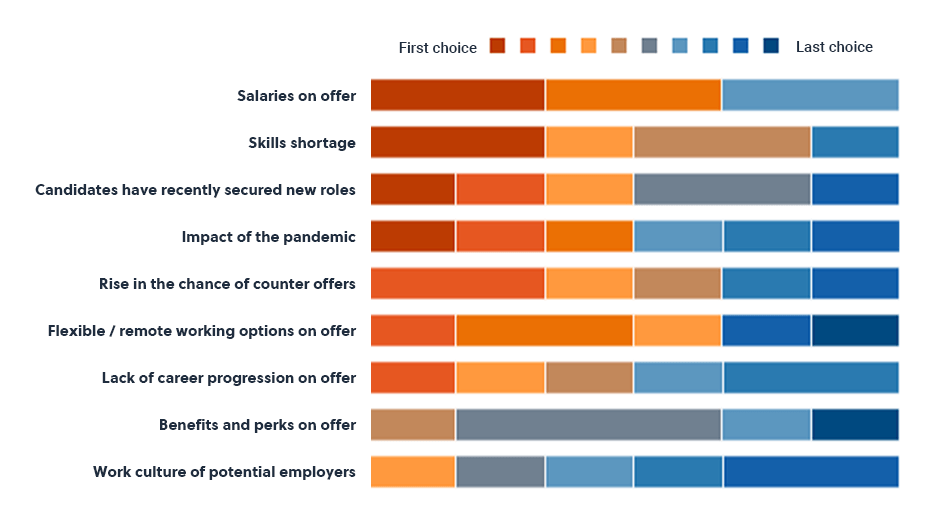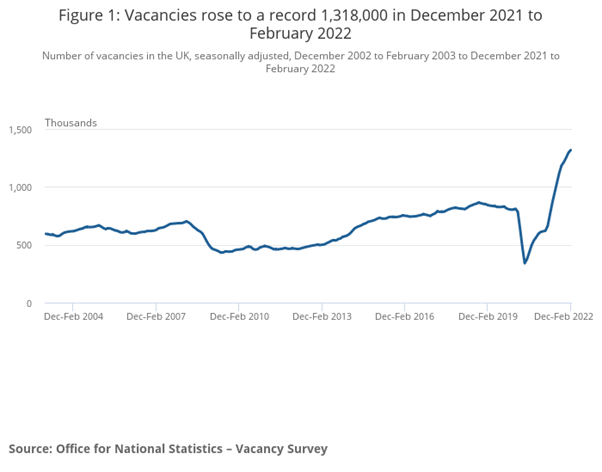State of the Sector: An Engineering Sector Report
With changing regulations, a marked skills shortage, economic instability and the bounce-back of manufacturing businesses post-pandemic, the Engineering sector has a lot to contend with. The industry is set to see record breaking demand this year, and businesses therefore have a high demand for skilled staff to support this growth. Data from the CTP Engineering Industry Sector Guide forecasts that ‘engineering employers will need to recruit 265,000 skilled entrants annually to meet demand for engineering enterprises through to 2024.’ This is a huge increase on last year’s forecast of 182,000, showing the scale of the demand for staff within the industry. But while there may be an increased demand, the labour market is undeniably tightening, with qualified professionals becoming increasingly difficult to find.
To give further insight into the state of the sector, we asked our Engineering team here at Heat to rank the factors that have had the greatest impact on the current candidate shortage. The results have ranked salaries offered as the greatest impactor, with the prevalence of the skills shortage following closely behind. While salaries are always likely to rank highly when it comes to hiring, the prevalence of the skills shortage cannot be underestimated. As Dr Jacqueline Hall states in The Engineer’s ‘Tech Trends 2022’ Report, “ensuring skills remain high on the agenda isn’t simply a voice trying to be heard within a deafening chorus; it is a practical reflection of the fact that without the right learning, delivered at the right time, there will not be a workforce capable of achieving the outputs necessary to drive our economy forward and maintain a reputation for excellence in engineering and manufacturing.”

In order to shed light on the state of the current hiring climate in the Engineering sector, we asked our specialist Engineering consultants to share their personal insights, their experiences operating within the market over the first quarter and their advice for the year ahead.
Engineering a sustainable future
In the aftermath of the COP26 conference and the ambitious pledges taken to reach Net Zero by businesses and world leaders alike, the Engineering and Manufacturing sector is leading the way in building a sustainable future. In an article written for The Engineer by David Cole he claims that, in relation to reaching the Net Zero targets promised, ‘an engineering mindset is the answer: an independent energy system architect is now crucial to ensure that the UK’s Net Zero strategies and ambitions are founded on practical, engineering risk-based analysis. This time now, post COP26, must be regarded as a turning point. From here, we must proceed with pace but also purpose: we must deliver the resilient, low carbon energy system we need to make our transition to Net Zero a reality.’ This desire to effect tangible change and make a difference through work is also being felt and reflected in the current hiring market.
“So far this year, I have really noticed the uplift of potential candidates who are looking for an opportunity to work for more mission or purpose-led organisations. This specifically includes renewable energy or engineering companies who are targeting a more sustainable impact on the world we live in. Clients need to be conscious of this: candidates entering the market currently have double the opportunities they had 2-3 years ago, and reasons aside from remuneration are becoming increasingly important from a talent attraction perspective.”
Mike Taylor: Associate Director

Education and Experience: Resolving the Skills Shortage
Ranked as the second most significant impactor on the hiring climate in the sector, the skills shortage is being felt across all levels of business. For graduates and trainees in particular, a lack of experience and skills is proving particularly damaging to their job search, as businesses are wary of hiring underqualified staff. But, as Dr Jacqueline Hall, Head of Policy & Strategy at EAL, points out: ‘it is vital to remember that within an ageing workforce, it is high quality apprentices and graduates who will have a fundamental role to play in a successful recovery’ (Tech Trends 2022 Report, The Engineer). A widespread lack of awareness around Engineering and Manufacturing as a viable career route, particularly in younger age demographics, is likely contributing to fewer apprentices and graduates entering the sector; however, businesses must also play their part in ensuring they are realistic in their recruitment requirements and are taking on those candidates who are entering the sector with less experience.
“The graduates who are coming through the pandemic naturally have very little industry experience. Companies are looking to hire candidates with the necessary experience to fit their requirements but are struggling. Companies must be realistic about the level of experienced candidates in the market and be prepared to take a chance on those with less experience.”
William Bartholomew: Associate Recruitment Consultant, Design and Development in Medical Devices


Recovering post-pandemic
While business in the engineering and manufacturing sector is bouncing back significantly, the after-effects of the pandemic are still having a significant impact. Andrew Wade, Senior Reporter for The Engineer states that “covid continues to dictate the agenda in lots of ways, with labour shortages, supply chain issues, consumer confidence and inflation all posing challenges in engineering and beyond.” Alongside this, Covid continues to impact the hiring market, with the knock-on effects being felt by businesses and jobseekers alike.
“Since the turn of the new year, the biggest challenge to recruiting has been the lack of available candidates in the talent pool. Skilled candidates have already secured new roles in the wake of the world opening up post-pandemic, and so the market is more competitive than ever. Candidates know their worth, and employers need to be prepared to pay a competitive salary, but also ensure they’re keeping up with the times: the classic 9-5 is being increasingly phased out in favour of working from home and flexible work patterns. In uncertain times, taking risks and spotting good opportunities when they arise should be everyone’s approach.”
Hadden Smith: Recruitment Consultant, Special Purpose Machinery Design

Regulatory Changes
The turbulence of the past few years, with changing regulations and new rules being enforced, has meant that the ability to react promptly and adapt business processes accordingly has become essential. But, in the medical device sector in particular, operating post-Brexit and post-pandemic has brought about legislative changes relating to how medical businesses can sell their devices and corresponding software both within and outside of the UK. These changes are now having a direct impact on the hiring market in the industry.
“With the ongoing changes in the Medical Devices Sector, and the release of the new MDD > MDR standards, there was a huge influx of roles and recruitment last year. Legislative changes implemented last year that need to be completed by 2023 also resulted in a rush of recruitment in preparation for this, and a lot of candidates have now moved and settled into a new role. Because of this, the current market has slowed down, and the candidates who are open to work often have other opportunities in their sector. This has put a lot of recruitment activity on hold until the new financial year which will open up new budgets for hiring. I’m anticipating more opportunities in the market to arise in preparation for this transition, but the biggest challenge will be attracting this top talent, and it will all depends on the benefits and overall package that companies can offer.”
Charlie Harrison: Senior Recruitment Consultant, Medical Devices (Quality and Regulatory)

Sell your business or lose out on candidates
rose to a new record of 1,318,000. This is an increase of 105,000 from last quarter, with half of the industry sectors showing record highs.’ In such a competitive market, rife with counteroffers and without sufficient skilled staff to meet demaned, clients need to work even harder to make their offering attractive enough – and offer a high enough salary. The knock on effect if they don’t is that skilled candidates are choosing to be self-employed. This allows the candidate to charge a higher day rate, but means they will miss out on enjoying the benefits and incentives of full-time employees. In order to attract candidates who know their worth, employers must offer competitive benefits, sell their business and benchmark their salaries accurately.
“The biggest change so far this year is that there are a vast number of jobs in the industry offering the same packages, which only include the bare minimum a candidate would expect. Salary and holiday are the most important components needed for someone to take a new role. Candidates can afford to be stubborn, and without offering better benefits or being willing to pay a little more to get the best experience, clients will miss out. Increasingly, candidates are now choosing the self-employed route as they’re able to charge a higher day rate. Ultimately, this costs clients more in the long run than offering an increased permanent salary to begin with.”
Alex Edwards: Recruitment Consultant, Electrical Controls and Instrumentation

“As there are far more companies hiring than previously, candidates are obtaining multiple interviews, receiving counteroffers and higher salaries. The biggest challenge for businesses currently and in the year ahead is attracting the right talent. Companies need to remember that, in times of candidate shortage, it is essential to sell your business to prospective employees.”
Joe Opie: Senior Recruitment Consultant, Precision Engineering and Manufacturing


In Conclusion
Those trends that ruled the hiring market throughout much of Q1 look set to continue into the year ahead. With candidates in short supply, vacancies on the up, it’s more important than ever that companies pay attention to the trends in the market and be willing to adapt to keep up.
It’s clear that salaries are on the rise, but companies still have other options to attract talent. By re-examining their recruitment processes and strategies, as well as reviewing and enhancing their benefits options, companies can make themselves more attractive to candidates who are looking to secure a new position.
For candidates, now has never been a better time to make a move. As we move towards the latter end of the pandemic, and confidence in the stability of jobs grows, candidates are in an extremely healthy position to make a career change that could garner them greater opportunity for growth and success, as well as a host of competitive perks and benefits. The Engineering sector is set to see increasing demand over the coming year, but they will need to bolster their recruitment efforts in order to secure the additional resources to keep up with the workload.